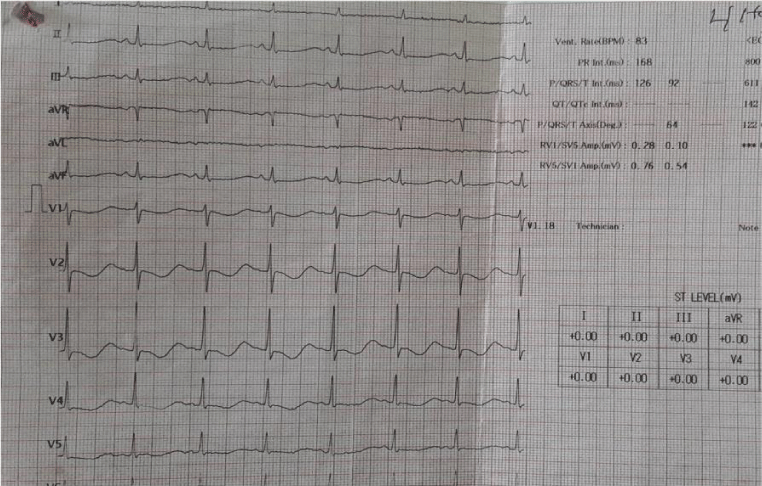International Journal of Clinical Endocrinology and Metabolism
Thyrotoxicosis leading to Renal Tubular Acidosis presenting as periodic paralysis – A case report
Sourya Sourabh Mohakuda1*, Rajiv Pakhetra2 and Naveen Yadav3
2Endocrinologist, Command Hospital, Pune, India
3Resident in General Medicine, AFMC, Pune, India
Cite this as
Mohakuda SS, Pakhetra R, Yadav N (2019) Thyrotoxicosis leading to Renal Tubular Acidosis presenting as periodic paralysis – A case report. Int J Clin Endocrinol Metab 5(1): 024-025. DOI: 10.17352/ijcem.000039Periodic flaccid paralysis is related to loss of tone and power transiently and which occurs repeatedly over time. Etiologies like channelopathies, myasthenia gravis and thyroid disorders are common. There have been case reports of thyroid disorders leading to periodic paralysis. The pathophysiology attributed to it is the increased uptake of potassium by the cells in the thyrotoxic state. Thyrotoxicosis is also an uncommon cause for distal renal tubular acidosis. In our case, we present a case of thyrotoxicosis leading to distal RTA presenting as periodic paralysis. On correction of thyrotoxic state with radioactive iodine ablation the renal tubular acidosis remmited both clinically and on arterial blood gas analysis. We report this case as there are very few cases of such nature which are reported worldwide.
Introduction
Thyrotoxic Periodic Paralysis is an important consideration in patients of South-east Asian origin presenting with acute onset proximal muscle weakness with hypokalemia and features of thyrotoxicosis. Renal Tubular Acidosis is due to inability of renal tubule to acidify urine, out of proportion to any reduction in glomerular filtration rate. Thyrotoxic periodic paralysis without any renal tubular acidosis has a normal arterial blood gas study with no evidence of metabolic acidosis.The case study herein described depicts a young male presenting with thyrotoxic periodic paralysis with an underlying Renal Tubular Acidosis, which in association with low potassium level and higher urine pH is suggestive of a distal RTA [1]. It is rare to have coexistence of both Thyrotoxicosis and distal RTA causing hypokalemic periodic paralysis. The case report highlights importance of extensive workup for secondary cause of distal RTA and resolution of RTA with treatment of thyrotoxicosis suggesting thyrotoxic state as etiology of distal RTA.
Case Presentation
25year old male, resident of Darjeeling with history of rightlower ureteric calculus with hydronephrosis was brought to the emergency department at 0600h with acute onset flaccid quadriparesis. He had history of recurrent episodes of such nature in the past which relieved after taking fruit juices.There was history ofgeneralised tremulousness of body and heat intolerance. There was also history of 10 kg wt loss over past one and half month with a preserved appetite.
On physical examination he had tachycardia, grade II thyromegaly with no eye signs of graves disease. There was symmetric hypotonic weakness of all four limbs. There was no bulbar, sensory, cranial nerve, cerebellar or autonomic involvement.Plantars were downgoing (Figure 1).
Urea/ creat- 35/0.7 mg/dl, Na/ K- 137/2.1meq/L (Table 1).
SerumChloride – 110 mmol/l.Urinay pH – 5.8,Urine anion Gap- 11 ( Urine Na – 80 meq/L, Urine K– 29meq/L , Urine Cl – 98 meq/L ) (Table 2).
Thyroid function test revealed T3- 2.08ng/ml (0.78-1.82), T4-24.21mcg/ml (4.6-13.0) and TSH- 0.19µIU/ml (0.5-6.5). Thyroid scan was done which revealed a diffuse high uptake in the thyroid gland. USG KUB- Normal study.R Factor/anti Ro/La/ANA - Neg
In view of the clinical features and above investigation findings, he was supplemented with parenteral potassium replacement. Following normalisation of potassium levels in blood his symptoms reversed. However he continued to be on oral potassium replacement. He underwent radioactive iodine ablation for graves’ disease [2]. His requirement of potassium gradually decreased and his ABG normalised over three months. He has been under follow up for one year. He has a euthyroid state, normal potassium levels and normal ABG readings. There has been no recurrence of symptoms post radioactive ablation.
Discussion
Hypokalemia is one of the most common cause for periodic paralysis. Literature suggests hypokalemia occurs in 2% of patients with thyrotoxicosis of any cause. It is because of the over sensitisation of Na+/K+–ATPase in thyrotoxic state [3]. The major triggering factors are cessation of effort following strenuous exercise and carbohydrate-rich evening meals. Similar presentation in males in the 2nd-4th decade with signs of thyrotoxicosis raises the suspicion of thyrotoxic periodic paralysis [4]. However in such cases of periodic paralysis due to thyrotoxic state the arterial blood gas analysis is normal and there is no urinary potassium loss. Renal tubular acidosis per se is an important independent cause of periodic paralysis. Arterial blood gas changes suggestive of distal renal tubular acidosis in presence of hypokalemia points towards hyperthyroidism being a possible aetiology for renal tubular acidosis. However other common causes like drugs, sjogrens and rheumatoid arthritis needs to be ruled out. The mainstay of treatment remains correcting the underlying hyperthyroid state and potassium supplementation. The reversal of renal tubular acidosis with correction of thyrotoxic state clinches the diagnosis of thyrotoxicosis being aetiology for distal renal tubular acidosis.
The coexistence of dual aetiology ie thyrotoxicosis and renal tubular acidosis, such as in our case is rare for causing periodic paralysis. Our review of literature revealed three such cases been reported earlier. The first case report was of a lady from Mexico who had thyrotoxic periodic paralysis, renal tubular acidosis, nephrocalcinosis and nephrogenic diabetes insipidus (DI). Our case had all of the above except for DI [5]. The second case was reported from China where a lady had thyrotoxic periodic paralysis and renal tubular acidosis. However she was positive for anti – Ro antibodies [6]. The third case was reported from Korea where the case had thyrotoxic periodic paralysis, diabetes insipidus, renal tubular acidosis with anti Ro titres positive but not significant enough to be labelled as Sjogrens. A possibility of Sjogrens in subclinical stage was considered in the above case [7]. If we consider the second and third case, the possibility of Sjogrens still could not be conclusively ruled out for being the aetiology for renal tubular acidosis. In our case, the work up for secondary cause of renal tubular acidosis was negative. The reversibility of the renal tubular acidosis with the case becoming euthyroid suggested thyroid being the aetiology for RTA. The nephrocalcinosis can be explained by impaired calcium metabolism in thyrotoxic state.
We conclude that our patient had distal renal tubular acidosis and nephrocalcinosis secondary to thyrotoxic state which reverted after achieving euthyroid status. However alternate commoner causes for renal tubular acidosis needs to be ruled out prior to labelling it being due to thyrotoxicosis. On follow up for an year, our case has been asymptomatic, remained euthyroid with a normal arterial blood gas analysis.
- Sood P, Paul G, Puri S (2010) Interpretation of arterial blood gas. Indian J Crit Care Med 14: 57–64. Link: http://bit.ly/2LnASDo
- Mumtaz M, Lin LS, Hui KC, Mohd Khir AS (2009) Radioiodine I-131 for the therapy of graves’ disease. Malays J Med Sci 16: 25–33. Link: http://bit.ly/2YUqV3o
- Ahlawat SK, Sachdev A (2019) Classic diseases revisited Hypokalaemic paralysis. Link: http://bit.ly/2Y6mLsa
- Lam L, Nair RJ, Tingle L (2006) Thyrotoxic periodic paralysis. Proc (Bayl Univ Med Cent). Baylor University Medical Center 19: 126–129. Link: http://bit.ly/2Sj4l1T
- Bolanos F, Ponce DLS, Garcia RG, Hernandez G, Quiroz S (1981) Hyperthyroidism associated with renal tubular acidosis, nephrocalcinosis, nephrogenic diabetes insipidus and periodic paralysis. Rev Invest Clin 33: 195-198. Link: http://bit.ly/2SgUrhe
- Szeto CC, Chow CC, Li KY, Ko TC, Yeung VT, et al. (1996) Thyrotoxicosis and renal tubular acidosis presenting as hypokalaemic paralysis. Br J Rheumatol 35: 289–291. Link: http://bit.ly/30yDYYK
- Im EJ, Lee JM, Kim JH, Chang SA, Moon SD, et al. (2010) Hypokalemic Periodic Paralysis Associated with Thyrotoxicosis, Renal Tubular Acidosis and Nephrogenic Diabetes Insipidus. Endocr J 57: 347–350. Link: http://bit.ly/2XQ1jsl
Article Alerts
Subscribe to our articles alerts and stay tuned.
 This work is licensed under a Creative Commons Attribution 4.0 International License.
This work is licensed under a Creative Commons Attribution 4.0 International License.


 Save to Mendeley
Save to Mendeley
